Healthy Office Snacks Posts
Office Meeting Snack Guide: We Snack, Therefore We Are

Picture this: you’re halfway through a department meeting. At least, you thought you were halfway through — you just looked at the time, and you still have another hour to go. Your team members are glassy-eyed, some seemingly about to nod off while others may well be disassociating.
It is a tragic sight, and one that’s all too common in meetings. In a best-case scenario, you halt proceedings and bring in the one thing that is almost 100% guaranteed to turn a meeting around: snacks.
Your colleagues brighten. They reach for whatever you’ve brought in and pour themselves water or top off their coffees. Meeting snacks aren’t just a nice perk; they’re fuel that will get them through the rest of the meeting and possibly even the rest of the day.
Man…what if you’d brought the snacks in earlier? You make a note to yourself to do that next time.
YES, SNACKS MATTER
In our ongoing quest to educate and connect local businesses with delicious meals, we admit that snacks sometimes fall by the wayside. But make no mistake: snacks are just as important to workplace morale and productivity as a fully catered lunch.
Why are snacks so powerful? They do all the stuff a good meal does, including raising blood sugar, which can improve focus and energy. And they do it without the lapse in work that comes from consuming a full meal.
Oh, yeah, the average snack requires a lot less cleanup, too.
Plus, who are we kidding? People just love food. The company that feeds its employees has a better chance at keeping them.
PLANNING YOUR OFFICE SNACKTIME
You’re probably on this page because you want meeting snack ideas, and yes, we’re going to get to them. But much like full meals, different types of snacks may be better-suited for different times of day or types of meetings. And while some meetings can go on for hours, a lot of them wrap up much quicker than that.
So stick with food that is easy to eat and doesn’t require a ton of utensils. Finger foods are a quick win here, as are pre-packaged items like trail mix or granola bars. As a bonus, they’re usually quick to clean up.
Before dropping everything to go food shopping, find out what kind of dietary restrictions and preferences you’re working with. Some of your colleagues may have gluten or nut allergies or be vegetarian. You’ll want to be considerate of their needs, too — that doesn’t mean you can’t bring in donuts or beef jerky, but make sure you’ve accommodated the needs of the entire team.
Let’s be clear: there is no one snack to rule them all. If you’ve got a group with diverse dietary needs, you probably won’t strike gold with a perfect snack everyone can eat (or wants to eat). But you can provide several choices that will a) fit your colleagues’ requirements, b) make them happy, and c) help them be more productive.
HEALTHY MEETING SNACKS
- Hummus and veggie cups: What goes well with creamy hummus? Veggies! Specifically crispy ones like carrots, celery, and bell peppers. If you really want to go all-out, bring in a few different kinds of hummus and let folks pick their favorites.
- Cheese cubes: Pretty much any cheese you can imagine is available in a cube. It’s tasty, it’s bite-sized, and did we mention it’s really easy to clean up? Throw in some veggies and crackers and you’ve almost got a full meal right there. Bonus: You can find dairy-free alternatives.
- Trail mix: Now, we said there’s no one snack to rule them all, but if there were…trail mix might be it. There are seemingly endless mixtures available, with fillings including dried fruit, chocolate, nuts, granola, carob, and more. It’s also easy to eat and generally doesn’t leave a mess.
- Popcorn: It’s light, it’s fluffy, and it’s satisfying. We love almost any kind of popcorn as a meeting snack, but if you have an itch for more flavor (and don’t mind compromising on the healthy aspect a little bit), then you can add all kinds of flavors.
- Fruit skewers: Sticks of fresh fruit pack a colorful punch; we like them stacked with berries, pineapple, and melon, but you can use any fruit that’s in season. They’re sweet and refreshing, and all you have to do afterward is toss or recycle the skewer.
- Apple slices: Apples on their own are a sweet and healthy snack, but they also provide plenty of real estate for spreads. You can go traditional with peanut butter or almond butter, or try something more daring, like cocoa-hazelnut or cookie butter.
- Yogurt: Creamy and often rich in protein, there’s a yogurt for just about every need. Plain, fruit-on-the-bottom, mixed fruit, and honey are all delicious options, and you can find plenty of dairy-free alternatives, too.
- Bagel and cream cheese: It’s a touch heavier than some of the snacks we’ve discussed here so far, and indeed could be called a substitute meal. But this old standby is tasty and filling, and might be just the thing to kick your meeting into high gear.
A LITTLE INDULGENCE IS OK
The more traditional office snacks may not be ultra-healthy, but you know what? That’s all right.
- Granola bars: They’re fast, they’re tasty, they come in all kinds of flavors and with all sorts of ingredients. Since they’re individually wrapped, they’re easy to hand out and clean up — a great fast snack during a brief lull in a meeting.
- Donuts: Hey, they’re a crowd-pleaser. They’re also available in endless varieties, from basic unglazed to artisanal creations that are almost too pretty to eat.
- Rice cakes: A light and crunchy snack that can be eaten on its own but mostly ends up as a vehicle for toppings (chocolate, hummus, nut butter, mayonnaise…we don’t judge).
- Cookies: Honestly, most people love cookies. They’re sweet, they come in many varieties, and you can find them with alternative ingredients to ensure you can take care of the dietary needs of your team.
LIQUIDS ARE IMPORTANT, TOO
- Water: Keeping water on hand is just the decent thing to do — but it doesn’t have to be boring water. Make flavored infusions available, or go the fancy route and pick up some sparkling water.
- Coffee: Yes, you should have the ultimate pick-me-up on hand. Bonus points if you bring in creamer and sweetener for those who need it. Okay, you should probably ask your team if they’d like decaf, too.
- Tea: Tea has many of the same benefits as coffee: it’s hot, it’s tasty, and many types have enough caffeine to give you a little boost. Ask your team what flavors they’d like and keep them in stock for future meetings.
SNACKS ARE IMPORTANT…BUT SO ARE MEALS
When it comes to productive meetings, snacks can make all the difference. Tasty, easy-to-eat options can help attendees stay focused and motivated, turning what might have been a slog into a productive event.
But sometimes — just sometimes — you need a real meal. If that’s the case, Waiter is here to help. Our Meals on Demand is a great way to try out our meal delivery and catering service without all the strings of a long-term commitment. Honestly, it’s almost a snack unto itself.
National Apple Cider Day: Bring in Something Sweet for a Staff Appreciation Treat
While you’re probably already immersing yourself into the season, there’s one event this week that can definitely bring some extra autumn flavor to the office. National Apple Cider Day is tomorrow, and it is the perfect opportunity to integrate a workplace wellness focus into your company culture – as well as a great way to promote collaboration among your staff. When it comes down to it, you might be wondering how a day dedicated to one of the most popular fall drinks in America could help you strengthen the value system within your company. So let us explain just how beneficial a day that includes apple cider can be, and share how to best bring this type of event to your team.

Photo Credit: Flickr user 3liz4
A Culture of Wellness
Helping your employees see the importance of a healthier lifestyle starts by making wellness centric to your company culture. But ‘wellness’ really goes beyond just offering an exercise program and throwing healthier options into your vending machines. It means offering a healthy mentality, which includes promoting mental well-being and good work habits as well. Encouraging your employees to take short group breaks and collaborate with each other on projects are both excellent ways to help them become better at problem solving and learn the importance of getting up and moving around throughout the day.
Finding unique opportunities – like National Apple Cider Day – can help you incorporate fun ways to encourage your staff to start taking on that healthier mentality. While hosting regular, weekly meetings that foster similar values is certainly important, using unique holidays to further instill a focus of wellness into your company culture is simply more memorable and helps to show your employees that work can include fun and creativity, and not just be about the daily grind.
Doing Food Holidays Right
When you want to bring a holiday like National Apple Cider Day to your team, think about the best ways to get your team together to collaborate and bond. For example, you could have Waiter.com cater an apple cider bar at a big breakfast meeting for your whole staff. Or you could look into having an apple cider barista over a particular hour of the day. Promote the event to your staff by encouraging them to grab some cider before a joining up with a smaller internal team or before they run to their 10 o’clock meeting. It will give them something to look forward to and help kick off gatherings in a positive way – which can also help get those creative juices flowing. Also, offering a specialty item over a particular hour during the day brings more individuals to a gathering place at the same time, which encourages natural collaboration – something that can help spark a more productivity when your employees return to their desks!
As you’re starting to plan your event, don’t forget to think about how to continue instilling healthy choices into your apple cider day. For example, the apple cider could be all natural and have no sugar added. Instead of bringing whipped cream as a topping choice, try offering other flavorful options like cinnamon and nutmeg. Hand out the cider in company branded travel mugs – not only will your staff love the freebie, but it’s also inexpensive advertising for your brand since the mugs can be reused. And don’t forget a side snack – something complimentary like gingersnaps made with flaxseed can be a delicious treat that also adds some fiber to employees’ day, boosting the health factor of your special treat.
Fun Boosts Employee Morale
The benefits of bringing a healthier mindset to your company culture is serious business, but that doesn’t mean that everything you do needs to be serious! Encouraging your team to have a little fun throughout their day is the best way to bring new values into your brand. If people are having fun while engaging in this new mindset, they’ll be much more accepting of it – and more likely to let that same mindset spill over into their personal lives.
When you’re ready to bring a fun food holiday to your company as a way to share a healthier lifestyle with your team, Waiter.com is here to help. Our corporate catering services can help you dream up the perfect way to bring all sorts of holidays to your business in a way that sparks creativity and promotes a culture of wellness. Learn more – and start planning your next food holiday – today!
Office Snacks: 4 Smart Swaps to Make for a Healthy Vending Machine Today
There’s a trend within the corporate office space to bring healthier options into every employee’s workday. And while offering exercise classes, healthy living seminars, and yummy food delivery options are all great ideas, there’s still one big offender at many offices around the country: the traditional vending machine. The often used, but little thought of snack dispenser is the office hot spot for anyone craving an easy morning snack or a mid-afternoon chocolatey treat. The problem is that most of the items offered by a traditional vending machine are filled with fat, empty calories, and little protein. This won’t help keep your staff full for the long haul and doesn’t provide any of the brain boosting nutrients that healthier foods offer.
And when it comes to stocking your vending machine with the right foods, you should feel great about being health conscious for the benefit of your employees. Incorporating more whole grains, fruits, veggies, legumes, and dairy into your diet can help you do more than just help you to stay fuller, longer – the combination of vitamins, protein, and antioxidants can help your staff be more energized, more productive, and happier overall. So if you’re looking to make some changes to what your vending machine has to offer, we’re right behind you – with four of the major swaps you can make for a healthy vending machine today.
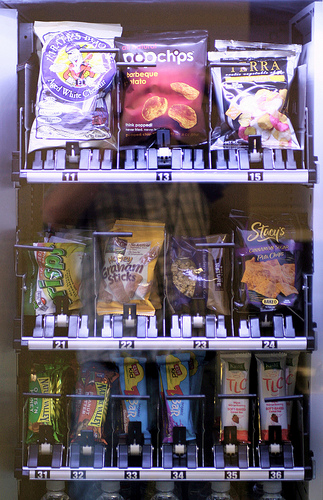
Photo Credit: Flickr user cliff1066
Swap soda for sparkling water: While it’s true that a little sugar or caffeine boost can help you get through the next hour of work, it’s not going to keep you going for the entire afternoon. And with nearly two-thirds of the American population not drinking enough water during the day, promoting healthy drinks, like sparkling water or low-calorie flavored waters, can encourage your team to contribute more to their daily intake. Getting enough water is essential for preventing headaches and dehydration, so it’s an easy way for your team to get a little healthier, one sip at a time.
Swap cookies for protein bars: The truth is, there are times when everyone needs a quick bite between meetings, especially when they don’t have time for lunch. And usually in these situations, a vending machine would give your staff the option of cookies or chips. Swapping out those cookies for protein bars can be a great way to fill your team up while still providing a lot of protein, giving them the energy and brain-boosting power they need to power through their next meeting, when they can finally order some lunch. This can help your employees – and the quality of their work – be much better for the wear.
Swap potato chips for lighter snacks: While they can be a tasty treat every once in a while, chips can be packed with empty calories – which give you nothing in terms of nutrition to get through the rest of your day. Swapping out these snacks for healthy option like light popcorn, a small serving of trail mix, or carrots and hummus – options that are filled with whole grains, fiber, protein, and essential nutrients – can be a great way to give your staff the boost they need to fuel up before a big conference call.
Swap juice for milk and yogurt: Not only can three servings of dairy per day help you control your waistline, they’re packed with nutrients like calcium for bone strength and are a good source of protein, which can both satiate hunger and help you feel more energized. Lowfat milk actually has the right balance of protein and carbs to be the perfect post-workout re-fueling drink – which can make it an even better addition to your healthy vending machine if you’re offering workout classes over the lunch hour. And with lots of high-protein Greek yogurt on the market these days, it’s easy to find options that your staff will love – maybe even more than a bag of gummy bears!
Helping your staff get healthy
Leading a healthy lifestyle isn’t something that happens overnight. But it can be a lot easier to make the conversion when you’re surrounded by nutritious options, including when you’re at work. So stocking your vending machine with healthier snacks can be a great way to support your staff in their efforts to incorporate wiser choices into their daily eating habits – as well as give them some healthy snack options when running to meetings between meals.
And when it comes to healthy meal delivery, you can even do more to bring healthy options to your team’s plate each day through Waiter.com’s custom cafe. We give you access to healthy menu choices from up to six local restaurants every day. And our easy-to-use flexible payment options let you allocate the tab to the company or your staff. Now that’s a way to really help your team understand the value of healthy eating!
Encouraging Productivity: Why to Offer Healthy Office Snacks as Part of an Incentive Plan
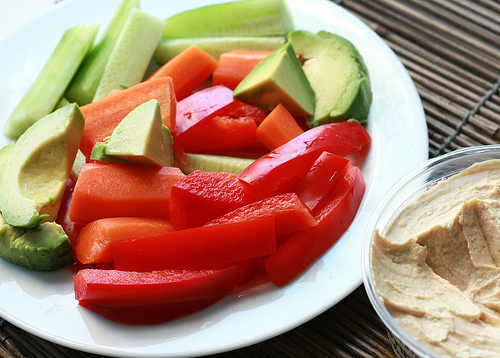
Photo credit: Flickr user SweetOnVeg
In the past, providing food perks beyond the office coffee and occasional donut day was something that most companies simply didn’t think about. But with our nation’s move toward a more healthy lifestyle – and a workplace that’s conducive to that style of living – more and more employers are choosing to provide healthier snack options to their staff. And it’s not just an office perk to attract bright, young talent to the table. Providing nutritious snacks at the office can encourage your staff to eat better.
Studies have shown that when employees have access to healthy office snacks as a perk to their job, they take less sick time, are more productive, and are less likely to become ill due to a cold or the flu. With the reduction in illnesses, many employers also see a drop in their health care expenses. And if that’s got your attention, here are some best practices you should consider when adding any kind of meal program to your office benefits package.
Be aware of food allergies
With food allergies and sensitivities on the rise, it’s important to understand what your staff can and cannot eat. For most offices, conducting an informal survey with your team can help you navigate choosing the right foods to offer. This doesn’t mean that every snack you offer has to perfectly align with one person’s restrictions – just that you should offer an easy alternative to snacks that contain common allergens. Options can also help encourage more people to take advantage of the program and see it as a great benefit to working for your company.
Fuel your staff
High fat foods take a long time for the average person to digest and sugary snacks can cause a quick spike in energy followed by a crash – limiting long term productivity for the day. Offering a variety of snacks that provide the right combination of protein, nutrients, and antioxidants is a great way to help your staff get over an energy slump, boost brainpower, and stay focused on their work. The best options to consider are the foods you hear about most frequently when it comes to healthy eating: different types of trail mixes, dark chocolate, fruits, and raw veggies.
Consider snack catering
With how busy you are, it can seem overwhelming to also have to plan healthy office snacks for all of your employees every day. Waiter.com makes the process easier on you through our catering and menu planning service. We can actually plan healthy meals for your office and have them delivered to your office every day – helping you continue to promote a healthy office environment without needing to put the legwork into providing the snacks each day. Getting started is simple – simply let us know what kind of program you’re looking to create, any restrictions of which we should be aware, and how frequently you want healthy food delivered to your office. We do the rest – and you get the credit!
A more productive workplace
Building a healthier workplace does more than just promote wellness for your employees – it actually helps decrease the business’ bottom line over time. Providing the right kind of snacks can get your employees excited about coming to work and push them to be more focused when they’re in the office, which means your company will be more productive as well. And with more companies than ever before offering office perks like this, adding a snack program to your office will certainly increase your company’s street cred with recruits.
When you’re ready to offer healthier snack options for your staff, Waiter.com can help – fill out this short form and we’ll get a plan for your business started today!
From Healthy Office Snacks to Jumping Jacks: 5 Easy Ways to Boost Creativity in the Workplace
Would you believe that simple tactics like having healthy office snacks or doing some brief exercises at your desk can help provide a jump-start to creativity in the workplace?
It’s true — creativity isn’t a static personality trait. Rather, it’s simply a way of thinking – coming up with novel solutions to old problems, or being able to spot connections between seemingly unrelated concepts. And as any artist can tell you, creativity ebbs and flows over time.
Feeling stuck in the “ebb” part of the equation? You may be in luck. In recent years, social scientists have undertaken research that has uncovered many easy “tricks” that can help promote the kind of unconventional thinking that’s crucial to creative work.
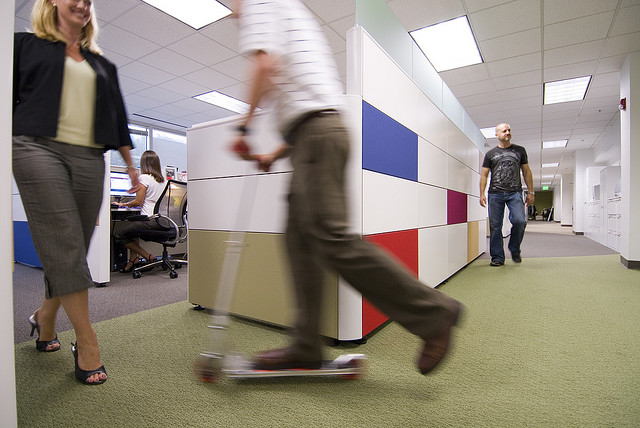
Image source: Flickr user DAXKO
Get inspired by their suggestions — and then put them into practice, and inspire yourself!
Get some exercise
This is where the jumping jacks come in. For years, writers and artists have attested that physically moving around can help get creative juices flowing – and recent research has backed up their anecdotal claims, with a study from the Netherlands showing that people who exercised regularly (four times a week) performed better on creative tasks than those who didn’t exercise at all. More research is needed to determine if even brief bursts of exercise can have an impact, but as Henry Thoreau famously said, “Methinks that the moment my legs begin to move, my thoughts begin to flow…”
Make time for play
It might sound silly, but there’s a good reason why employers like Google, Zynga, and Whole Foods are paying attention to “play experts” (and hosting foosball tournaments and beach volleyball games on company time). Some studies have shown that allowing employees time to play – meaning, engage in an activity they find pleasurable in a laid-back environment – can boost creative thinking and productivity. Even something like a crossword puzzle during breaks counts!
Feed your brain – literally
When you skip a meal or let yourself go too long without eating, you’re depriving your body and brain of the fuel it needs to perform at its best. So boost your energy and your creativity by having a few healthy office snacks available: a handful of almonds, a piece of fresh fruit, or even a bowl of popcorn can help keep you focused on the work at hand.
Meditate on nothing at all
Mindfulness and meditation are becoming increasingly popular tactics to combat stress in the workplace, and research has shown that meditation specifically can also be useful for boosting creative divergent thinking. Taking a few minutes to try and clear your mind, and focus on your breath and your body, is certainly worth trying when you’re stuck on a problem or feeling “trapped” in your own thoughts.
Take a break with a coworker
Taking regular breaks from involved tasks promotes creativity. Group breaks boost productivity. Combine the two, and you may find that talking through a tricky problem with a trusted coworker can provide the safe sounding-board space you might need to discover the creative solution that was just out of reach while you were sitting at your desk!
While creativity is an individual pursuit, you aren’t totally alone in your efforts to become more free-thinking! Waiter.com can help ensure you always have healthy office snacks at hand, and even save you time by delivering lunches and meals right to your office door. (But the jumping jacks are entirely up to you.)
Why Your Office Should Celebrate National Eat a Peach Day!
Does any fruit signal summer more than the peach? Plump and juicy and sweet — and they never taste better than during their peak, which is happening right now. Summer may be winding down, but isn’t over yet – August is National Peach Month, and today just happens to be National Eat a Peach Day! And there’s good reason to celebrate as you plan out your workday snacks and office meals. Peaches aren’t just juicy and delicious: they’re a very healthy fruit. One large peach only has about 70 calories (and less than half a gram of fat) and contains nearly 20% of your recommended daily dose of vitamin C. You’ll also find approximately 10% of your daily recommended potassium, fiber, and vitamin A — and a bit of iron and magnesium for good measure!

Image source: Flickr user calliope
What does this mean, exactly? It means that peaches aren’t just a low-calorie snack — they’re able to help promote overall good health. Thanks to the vitamin C, peaches can boost immunity, and help promote healthier skin and hair. The vitamin A in peaches contributes to healthy eyesight, while potassium helps rid the body of excess sodium and maintain healthy blood pressure. Peaches also contain antioxidants, like beta-carotene, the cancer-fighting pigment found in richly colored fruits and vegetables. And fiber, of course, is the key to feeling full after eating: which means snacking on a peach or including the fuzzy fruits in your office meals will help you avoid the vending machine later in the day! Convinced yet? If you want to celebrate National Eat a Peach Day today — or incorporate these delicious fruits into your regular diet — here are just a few ways that peaches can be a part of your office meal routine:
- At breakfast, skip the sugary fruit-on-the-bottom yogurt and top plain Greek yogurt with sliced peaches. It tastes better, and is way better for you.
- For a healthy lunch, order a salad with greens like arugula, sliced peaches, goat cheese, and nuts — talk about summer on a plate!
- Keep an eye out for peach salsas at your favorite pseudo-Mexican restaurants: it may not be authentic, but in the summer months, fresh peaches can add a fantastic sweetness to spicy salsas.
- Add freshly sliced peaches to a cold glass of H20 to make “spa water”, or use peaches to flavor iced tea for a refreshing alternative to afternoon coffee. Not only will it taste delicious, but you’ll love snacking on the fruit at the bottom of your glass!
- Just keep it simple. A peach, neatly sliced, makes the perfect mid-day snack — especially when paired with some almonds or another heart-healthy nut for a bit of extra protein and fiber.
Freshen up your office meals with a little help from peaches – and Waiter.com! We have a wide range of menus so you’ll always find the perfect dish, and our online ordering and prompt delivery make it easier than ever to have healthy and wholesome lunches (or breakfasts!) brought right to your office.
Sweet Pickings: The 6 Best Fruits for Office Snacks
It’s halfway through the workday and you’re starting to feel that little dip in energy. What do you do?
- Pour (another) cup of coffee and hope it does the job;
- Scarf down a sugary snack;
- Do a bunch of planks or run around the office a few times.
Or…you could eat some fruit.
Hang on, don’t click away yet. Fruit is pretty much the ideal office snack. It’s sweet, tasty, filling, and usually way, way healthier than the candy bar or chai latte you were thinking about getting. Fruit is often loaded with fiber and nutrients, both important components of a proper diet, and they can provide that much-needed energy boost.
But what kind should you keep on hand for your colleagues? Not everyone likes every kind of fruit. And despite its general goodness, not all fruit is created equal when it comes to healthy eating (or taste). Also, fruit is perishable, and can be messy.
We took all those things into account when we put together this list of the six best fruits for offices. They’re healthy, range from tart to sweet, and are generally pretty easy to clean up. They’re also typically available year-round, though they may be easier to find or less expensive in some seasons.
The 6 Best Fruits for Office Snacks
1. Raspberries
Raspberries are healthy and filling, so they rank pretty high on our office snack list. Low in sugar and high in fiber (with eight grams per cup), raspberries also happen to be delicious and packed with antioxidants.

2. Blueberries
Blueberries are a very close second, thanks to both their deliciousness and their potential positive impact on your brain. (Seriously, scientists have studied how blueberries improve cognitive function and even mood.)
3. Apples
So it turns out the old phrase “An apple a day keeps the doctor away” may actually have some legs. Apples are jammed with nutrients and antioxidants, and they’ve even been linked to heart health. Pro Tip: Eat them with the skin on to maximize your fiber intake. They’re also among the easiest fruits to transport; just grab one and go!
4. Oranges
Oranges are famed for containing a ton of vitamin C (okay, it’s more like 70 milligrams, but that’s a lot in one serving). But oranges are also great sources of fiber, potassium, and calcium. They do have a fair amount of sugar, so go for the whole fruit (with its fiber) rather than juice. They can also get a bit messy if you’re peeling them quickly, so keep a paper towel close at hand.

5. Kiwis
Kiwis are another vitamin C powerhouse, but again, you’ve got to eat them with the skin to get at their fiber content. Vitamin C isn’t just good for your immune system, by the way; it also helps wounds heal and can improve your mood.
6. Avocados
Let’s clear one thing up first: yes, avocados are a fruit. They’re also one of the tastiest ways to get monounsaturated fat, which is a big deal for your heart.
Fruit Might Just Be the Perfect Snack
In case you hadn’t realized it, the fruits listed above all have one thing in common: vitamin C. Okay, they also have varying levels of fiber, antioxidants, and other important nutrients. But overall, almost any kind of fruit is going to be a snack that tastes good and is good for you.
A few other fruits we like are:
- Guava: Like the apple, you’ll want to eat this fruit with the skin on to max out your fiber and minimize cleanup.
- Bananas: They’re practically a meal unto themselves, and extremely portable. Just be wary of keeping them out too long; most go mushy within a few days if they’re not refrigerated.
- Cherries: They’re small, they’re sweet, and they have heaps of fiber and potassium. Yes, they have pits, so you’ll need a bowl or napkin to spit them into. As a side note, cherries are easiest to obtain in the spring and summer.
- Grapes: Grapes are sweet, come in a variety of sizes, and are fairly easy to snack on and clean up (just throw the stems out when you’re done). They can also last a bit longer (sometimes a couple of weeks!) than other fruits when refrigerated.
But really, this is just scratching the surface. You’ve got a lot of choices when it comes to fruits, and honestly, you really can’t go wrong! How you bring it in is totally up to you. Maybe your business keeps the kitchen stocked with fruit. Or maybe you just let your team know they can order a side of fruit or even an entire fruit dish with many of the box lunch meals Waiter delivers.
Who knows — someone might want to swap out French fries for a side of strawberries or cantaloupe. So go ahead, order the fruit cup! We’ll make it happen.
Go Nuts For Healthy Office Snacks: New Study Shows Eating Nuts Reduces Disease
When hunger strikes at 3 pm in the office, it’s hard to resist the call of the vending machine and its wares: crispy, salty, sweet, crunchy; whatever you crave, it can be yours for a few quarters. Think twice, though, before you press a button: every time you choose a little foil bag of potato chips or cookies over that unpopular packet of mixed nuts, you may be passing up a chance to live longer!
When it comes to healthy office snacks, new studies continue to show that nuts are one of the best choices you can make. People who snack on a handful of nuts every day live longer than those who don’t. They can reduce the risk of some cancers, the need for gallbladder surgery, and developing Type 2 diabetes. Some nuts may even have anti-aging effects due to their resveratrol content — and people who eat nuts daily are less likely to gain weight.
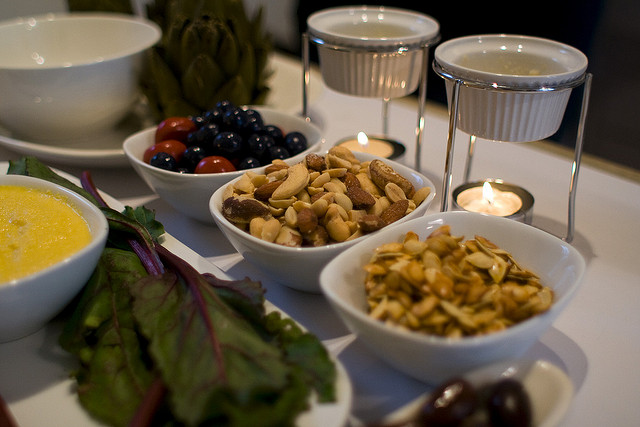
Image source: flickr user TenSafeFrogs
Anyone who went on a diet in the 1990s may be experiencing a flabbergasted knee-jerk reaction to this news. That’s right — although we were all told at the end of the 20th century that 1) snacking is bad, and 2) if you do snack, you should eat carefully engineered fat-free diet foods, not foods that are higher in calories and fat like nuts, we were woefully misinformed.
Most nuts are high in fat, it’s true – but they’re high in the healthy monounsaturated fats that don’t raise cholesterol. They’re also packed with fiber and protein, which means hungry people who snack on nuts will actually feel full and be less likely to overindulge later (we’re looking at you, potato chips). Sure, you don’t want to throw back an entire container of Planter’s in one sitting, but a handful of nuts will do a lot more to satisfy your hunger than the empty calories you usually eat out of a vending machine.
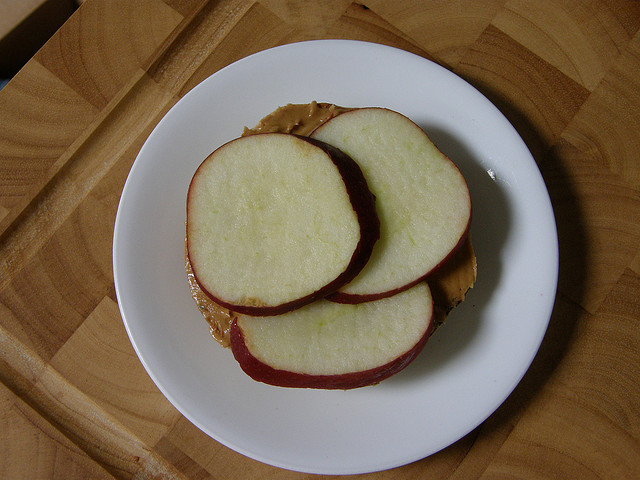
Image source: flickr user thefranksterk
So what kind of nuts should we be munching on for our daily office snacks? Nutritionists suggest that eating a mix of different tree nuts (like almonds, walnuts, Brazil nuts, pistachios, and pecans) is better than snacking on just one variety, since each kind contains its own unique blend of nutrients.
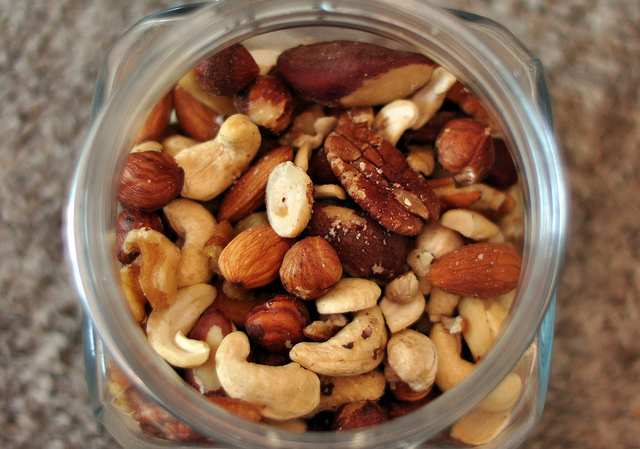
Image source: flickr user TheTravellingBum
Since nuts lower the risk of obesity and other chronic diseases, which send health care costs skyrocketing, any office that wants to prioritize employee wellness would be well-advised to make nuts part of the daily routine! Here are a few ways to go nuts at work:
- Of course, a bowl of mixed nuts in the break room is a great start! Add a little dried fruit for sweetness, too.
- During office breakfasts, serve sliced fruit and natural nut butters (i.e., without lots of added sugar) along with whole wheat bagels for a smart alternative to donuts.
- When you order salads for lunch, provide a dish of crushed mix nuts to sprinkle on top instead of croutons.
- Catering tables can be a goldmine for nut-studded dishes: think toasted almonds in green beans, walnuts and raisins mixed into brown rice, or salmon with a crust of crushed nuts.
- Include high-quality peanut butter sandwiches on the next box lunch order — you might be surprised at how quickly they’ll go!
When it comes to mixing up the office food program, the experts at Waiter.com are ready to help stock your workplace with healthy, flavorful meals and snacks! Easy online ordering and Virtual Cafeteria Service ensures that everyone will have plenty of wholesome food on hand… and no excuse to give in to the vending machine.
Mindless Eating at Work: Put Down the Bag of Pretzels & Step Away From Your Desk
If portion control is key to weight loss success – as much of the current research on American diet suggests – then what determines how much we eat?
It’s not always hunger, which won’t come as groundbreaking news to anyone who’s sat at their desk with an open bag of pretzels, only to look down ten minutes later and discover with surprise that half the package has vanished. Environmental eating cues, from the size of our plates to the background music we hear, can have a substantial impact on what we eat. Unfortunately, this is especially true when it comes to eating at the office, when we might have less control over our environment than we do at home. There are a few things to keep in mind, however, that will help you make better choices while you’re eating at work.

Image source: flickr user Victor1558
When you start looking into the science behind portion control, one name comes up over and over in articles and studies: Dr. Brian Wansink. As the head of the Food and Brand Lab at Cornell University, Wansink has conducted numerous experiments that demonstrate how powerful environmental effects can be. In one oft-cited study, movie theater attendees who were given giant buckets of popcorn ate almost 175 calories more on average than people given smaller buckets – and almost everyone ate a considerable amount, even though the popcorn was five days old. Wansink is also the mastermind behind the infamous “bottomless” soup bowl experiment, where a specially engineered self-refilling soup bowl led restaurant diners to eat nearly 75 percent more soup (and calories).
Wansink’s research has clearly identified numerous factors that contribute to what he calls “mindless eating”: the kind of eating that occurs not due to hunger, but the power of convenience and subconscious cues. As Wansink tells the Boston Globe, “”The big danger is that we all think we are too smart to be influenced by environmental cues.”
Luckily, Wansink has also made it a focal point of his career (and a fair amount of books sold) to provide practical advice on how people can overcome these environmental cues and improve their eating habits. So, how can the average American put Wansink’s wisdom into practice when it comes to eating at the office? For starters…
Don’t eat out of a bag or box. When you’re reaching into a bag of chips or box of crackers, there’s no cue to signal when you’re done – so you’re more likely to keep munching away. Wansink advises that we should always put a portion of a snack on a plate, and put the bag back in the cupboard. Rather than keeping a big bag of snack food on your desk, portion a reasonable serving size into a baggie and leave the larger package in the kitchen (or at home).
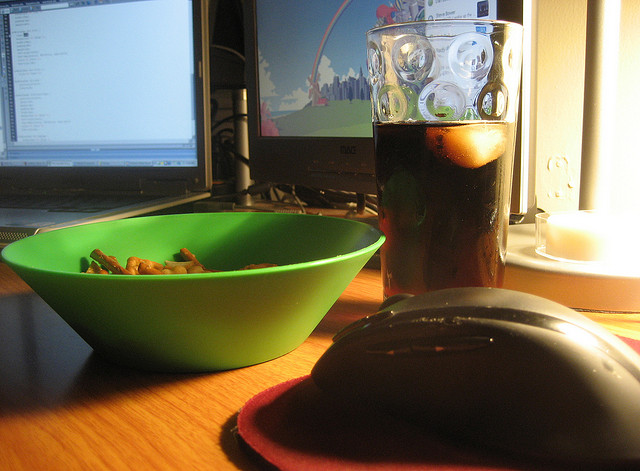
Image source: flickr user Jayeb333
Choose a smaller plate. Over the last few decades, the size of the typical dinner plate has expanded along with Americans’ waistlines. Wansink reports that when we eat off a salad plate instead of the typical 12-inch dinner plate, the average person eats 22 percent fewer calories. Even if the break room is stocked with dinner-size plates, keep a smaller one on hand for your own use.
Don’t make lunch a multi-tasking event. For the same reasons Wansink and other experts advise not to watch TV while you eat, you shouldn’t eat while you work at your computer. You won’t be paying attention to your internal cues, like satiety and pleasure, and you’ll end up eating more food while enjoying it less. This is why offices should prioritize having a separate break room for meals: getting away from the desk to eat not only affects employees’ ability to practice portion control, but will boost mood and concentration levels throughout the day.
Start with salad, vegetables, or fruit first. When the office has a catered buffet lunch or decides to share family-style takeout, make a beeline for the salad or vegetable dishes before you hit up the meat and potatoes. Wansink’s research shows that we eat more of what we’re offered first – in one experiment, when fruit was offered first at a breakfast buffet, almost everyone (86 percent) took some. When it was offered last on the line, just over half (57 percent) added fruit to their plates.
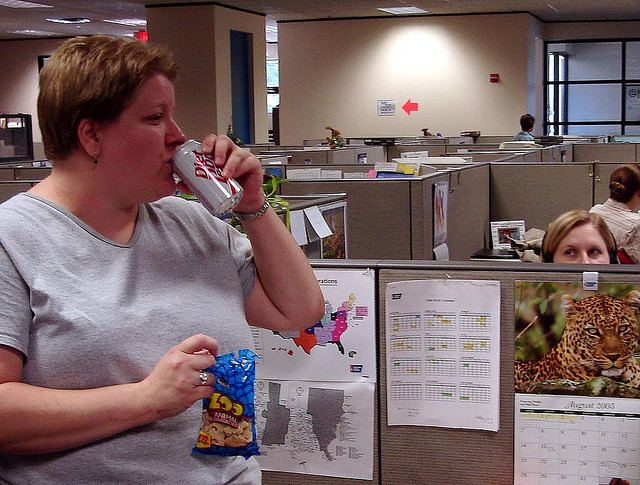
Image source: flickr user katedahl
Be a trendsetter, not a follower. Peer pressure affects our eating habits, too. We’re more likely to order fries if our dining companions do so first, and the same goes for salad. So when it’s time to collect the lunch order, be bold about choosing a healthy takeout dish like brown rice, veggies, and omega-3 rich salmon instead of a cheeseburger or pizza. You might not only improve your diet, but your coworkers’ as well.
Leave the mindless vending machine lunches behind. With Waiter.com‘s easy online ordering and quick delivery, lunch can once again become an occasion to socialize with coworkers and truly enjoy a delicious, nourishing meal – without ever leaving the office.
How Healthy Eating and Company Catering Can Boost Employee Productivity
Do you ever notice a sense of listlessness, lack of concentration, or just general loss in productivity at the office? Before you begin to worry about motivation and company morale, look at what your employees are having for lunch. Research shows that employees’s eating habits can have significant impact on their productivity.
A 2012 study in the journal Population Health Management found that employees who ate an unhealthy diet were 66 percent more likely to experience a loss in productivity than their counterparts who regularly consumed fruits, vegetables, and whole grains. The difference in diet was more likely to make an impact on productivity than exercise habits (50 percent) and smoking (26 percent).
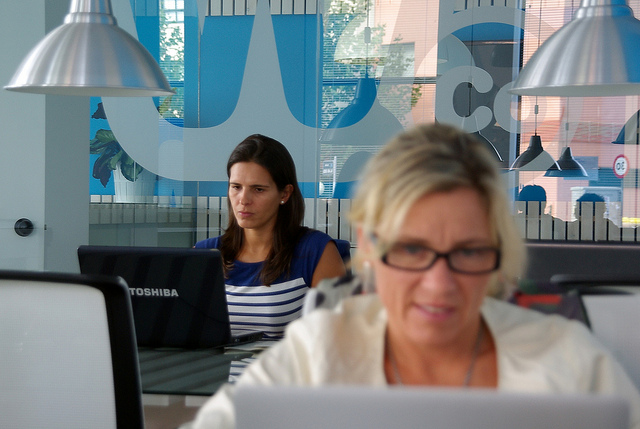
Image source: flickr user WeKCo
Interestingly, productivity loss was more likely to show up in younger employees (30 – 39) and less likely in those 60 and older. And clerical or office workers were were far more likely to report decreased productivity than employees working in industries like construction and farming — meaning that these findings have potentially huge impacts on the majority of today’s workplaces.
“Total health-related employee productivity loss accounts for 77 percent of all such loss,” said Ray Merrill, the study’s lead author and a health science professor at Brigham Young University. The study didn’t just focus on missed days of work, but on what the authors refer to as a lack of “presenteeism” — employees who come into the workplace, but don’t perform their best.
Obviously, this loss in productivity can lead to substantial financial consequences. What’s a company to do?
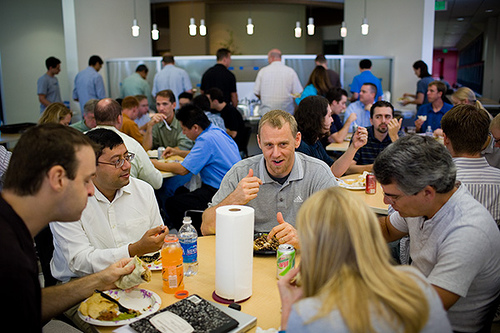
Image source: flickr user LinkedIn
Johnson & Johnson is one corporation that famously puts a high priority on employee wellness. Their company-wide wellness programs include health-risk assessments, corporate cafeterias serving nutritious food, digital health coaching, and on-site fitness centers (or Wii Fit machines!) in most of their U.S. workplaces — from warehouses to corporate offices. Their program is often cited as a successful example of employee wellness programs translating to health care cost savings, but Johnson & Johnson doesn’t only look at insurance costs as evidence that their program is worthwhile.
“We see this as one of our competitive advantages,” Fikry Isaac, vice-president of Johnson & Johnson’s global health services, told National Journal in June. Johnson & Johnson knows that healthier employees not only translate to lower health care costs: they are more productive, missing fewer days of work and having higher levels of the “presenteeism” Merrill and his colleagues examined in their research.
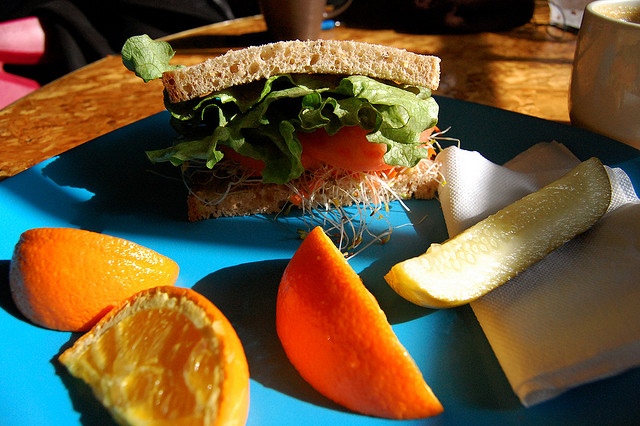
Image source: flickr user Justin Snow
Even without employee gyms or on-site cafeterias, any company can focus on improving their food offerings to promote wellness and productivity. Rather than stocking the break room with sugary treats that may impair memory and concentration, provide healthier options like nuts, berries, and green tea — all considered brain-boosting snacks.
Improve employee morale and concentration levels by serving a healthy catered office breakfast on occasion, with a menu focused on nutritious foods like oatmeal or egg white omelets instead of doughnuts and pastries. Order healthy takeout for office lunches or ensure your company catering plan includes a wide variety of nutritious food.
Start by putting an emphasis on healthy food in the office, and the company-wide conversation about employee wellness can grow from there. The expert team at Waiter.com is ready to work alongside you, building a culture of wellness and a team of healthy, productive, well-fed employees!
New Year’s Resolutions at the Office: How Employers Can Support Workplace Wellness Goals
We know the statistics are bleak: out of the roughly 40% of Americans who make New Year’s resolutions, only 8% actually keep them. Nonetheless, we try — and especially when it comes to our health.Eating right and exercising regularly are consistently at the top of the list. And given that most of us spend around half of our waking hours at work, it’s hard to deny that our workplace environment can have a significant impact on whether or not we keep those resolutions.
As the evidence continues to indicate that companies should invest in workplace wellness and employee health, it stands to reason that supporting New Year’s resolutions is worth the time and effort of most employers. Here are just a few ways to take expert tips on keeping resolutions and implement them in the office!

Image source: flickr user tedeytan
1) Lead by example.
Before you can support others’ goals, you’ll need to gain credibility by setting your own. To successfully promote wellness in the workplace, senior management needs to be actively on board. When the boss takes a half hour at mid-day for a brisk stroll around the block and talks about his goal to stay away from the vending machines in the afternoon, it sends a clear message that health and wellness are priorities.
2) Make resolutions social.
Sharing goals with others is a frequently cited resolution-keeping tip, and one of the easiest to implement in the office. Create like-minded “resolution clubs” for staffers who are looking to improve their eating habits, exercise more frequently, or even quit smoking. As behavioral science expert Lee Newman writes for Forbes.com, “Behavioral research has shown that in many common situations, publicly stating an intention increases the likelihood of follow-through by creating accountability and commitment… co-workers can serve as a source of feedback and help track progress toward a goal.” Ask your staff to check in with one another, asking whether they went to the gym over the weekend or how their commitment to cut back on sugar is going. You could even organize a team for a charity walk or run in the early spring, creating a long-term motivation to keep up new habits. Creating community is key — when people know their coworkers will be checking up on progress, they’ll be more likely to stick to their goals.
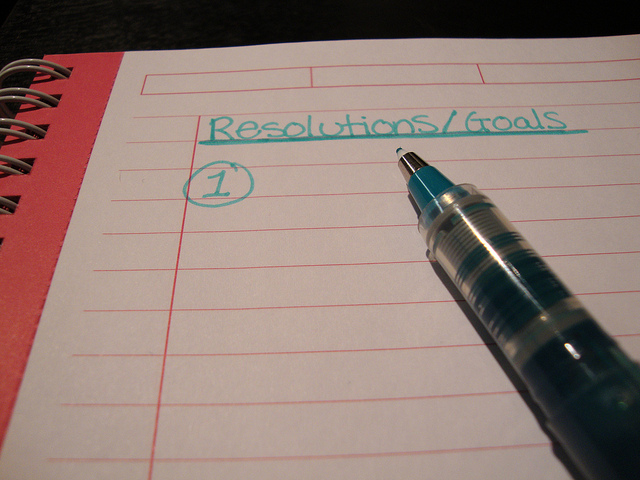
Image source: flickr user creepyed
3) Encourage simple, trackable goals.
Simply resolving to “lose weight” means you can’t really tell when you’ve reached your goal, while pledging to eat fruit instead of donuts for breakfast is easy to track. Going to the gym everyday is a huge lifestyle change if you haven’t lifted a weight in years, while biking three times a week and taking the stairs instead of the elevator are two relatively simple, straightforward changes. While lofty goals are tempting to dream about, they’re also the least likely to be kept. Encourage workers to be specific, and make resolutions with progress that can be easily tracked. “Making your resolution more concrete allows you to better monitor it. If you fall behind, you know,” University of Oklahoma psychologist Melissa Burkley tells Time. This also makes it easy to encourage accountability; it’s much more comfortable to ask a coworker if he’s been eating fruit rather than how much he weighs this week!
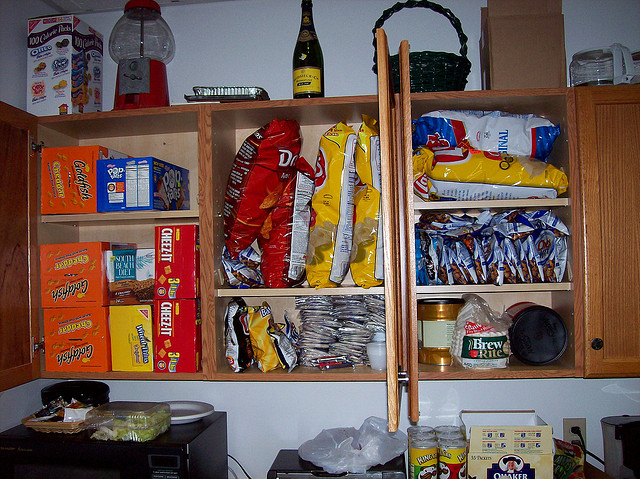
Image source: flickr user daveboudreau
4) Provide healthy options in the lunch room.
From morning bagels to pizza dinners, office meals can present huge challenges to employees who have resolved to watch what they eat. Collaborate with the office manager in charge of ordering food, and ensure that a wide variety of healthy takeout options are included: vegetarian pizzas, brown rice and steamed vegetables with Chinese food, and salads with everything! Make it easy for workers to drink water (whether bottled, filtered, or even sparkling) over sodas, and provide plenty of healthy snacks like nuts and fruit instead of candy or chips.
New Year’s resolutions aren’t easy, but they do present a valuable opportunity to make health and wellness a part of the daily conversation in the workplace. Waiter.com can help your staff stick to their goals with customized online ordering and even a Virtual Cafeteria Service, allowing for a wide variety of healthy foods to find a home in your office!
New Study Says That Eating Healthy at Work Requires Planning — Not Willpower
Do you think willpower is the key to achieving your diet goals and keeping your New Year’s resolutions? Think again. A new study from the University of Lisbon reports that planning, not willpower, may be the secret to successfully changing your eating habits — especially in situations ripe with temptation, like the office.
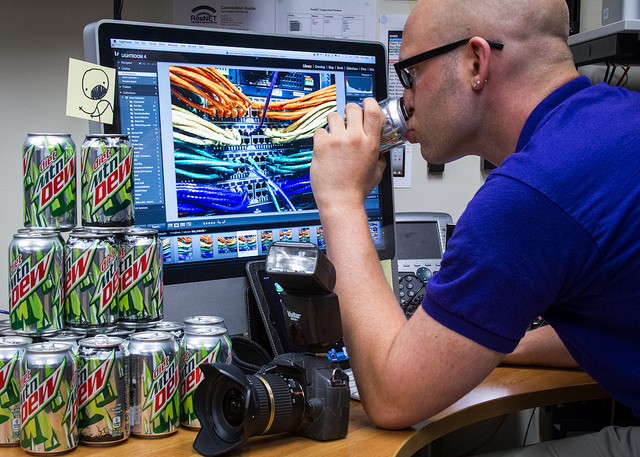
Image source: flickr user UWW Resnet
Published in the British Journal of Health Psychology, the study used detailed questionnaires to examine when and how participants ate healthy foods (fruits and vegetables). Over three weeks, more than 200 people described their eating habits, their intentions to eat healthy foods, their thoughts on how their health would be impacted if they ate more fruits and vegetables, their plans for meeting their goals, and their strategies for overcoming obstacles.
Who wanted to eat more fruits and vegetables? The people who understood the benefits of doing so, and felt confident that they could do it. However, the study found that the actual consumption of the healthy foods was optimized by people who had ideas in mind about how to deal with tricky situations and obstacles. Planning ahead, not confidence or willpower, was the difference-maker.

Image source: flickr user the Italian voice
As the study’s lead author, Cristina Albuquerque Godinho said, “We found that having strategies in place to deal with a range of eating situations that could undermine good intentions is very important, and helps people to regulate their daily dietary choices.”
What does this mean for the workplace? We all know that between birthday cupcakes, candy bowls in the break room, and pizza delivery lunches, it can be all too easily to slip up and “cheat” on our good intentions. The key to eating healthy at work, according to this study, is to have a plan in mind for how to deal with these obstacles when they come up.
Here are just a few ways to plan ahead for office diet obstacles:
1) Set specific goals. A blanket “no fatty foods” ban is hard to follow, and will make you feel like you’re depriving yourself when the rest of the office orders pizza. Instead, strive to stick to only one slice piled with veggies, and a hearty serving of salad.
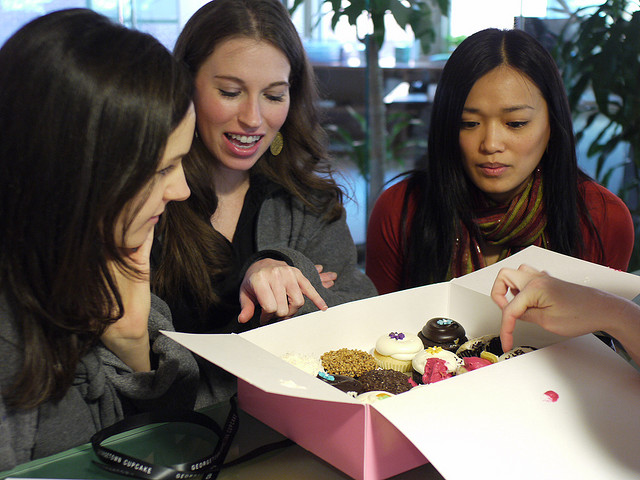
Image source: flickr user elstudio
2) Ask for accountability. When you know a birthday celebration is coming up, share your goal of limiting sweets with a coworker ahead of time, and ask her to split a cupcake with you on the day of the party. Her support will make it much easier to stick to — and enjoy guilt-free — one small serving of an indulgent treat.
3) Know your takeout options. Do a little advance research and scope out the nutrition info from your office’s favorite delivery spots. Choose a go-to tasty yet healthy takeout option from each menu, and let the person in charge of ordering know your preferences. That way, when someone decides “Hey, it’s Mexican day,” you’ll be all ready to order up a black bean bowl with avocado instead of a cheesy burrito.
4) Request changes. Don’t be afraid to ask your office manager to swap the candy bowl for a fruit delivery, or at least to add some healthy snack options to the break room. The research is on your side: workers are more focused when they have brain-boosting foods like nuts or whole grains rather than sugary treats.
5) Keep records. Whether you use old-fashioned pen-and-paper or a sleek mobile health app, food diaries were another factor in the study that helped participants meet their food goals.
When it comes to eating healthy at work, you may have no better ally than Waiter.com. Customizable online ordering and regular meal deliveries mean you can always plan ahead to meet your diet goals — and as you now know, that’s the key to healthy eating!
From Corporate Catering to Wellness: What America’s Happiest Companies Have in Common
The newly crowned happiest companies in America (according to rankings from CareerBliss.com) include a pharmaceutical giant, a health insurer, and whatever exactly GE is these days. What do they have in common? These companies understand key factors to employee happiness, like work-life balance, relationships between coworkers, growth opportunities, and work environment.
One other thing? With few exceptions, they all have really stellar workplace wellness programs and healthy corporate catering plans.

Pfizer, the pharmaceutical company that claimed the top ranking for employee happiness, emphasizes on-site fitness centers, smoking cessation programs, and healthy cafeteria offerings as part of its “Healthy Pfizer” program. At Kaiser Permanente, the insurer who took #2, the companywide employee wellness program is centered around healthy choices: from stocking healthy food in vending machines to offering yoga classes on their campuses. GE even created an internal certification program for its numerous work campuses to be officially recognized as “HealthAhead” sites. With 50 measures ranging from smoke-free workplaces to nutritional labeling in cafeterias, GE places a huge emphasis on the personal choices employees can make to improve their overall health.
Google, at #21 on the happiness index, is famous for its food philosophy: providing free, high-quality meals at restaurants and cafes throughout its campus. And when faced with the recent discovery that workers were probably overindulging on M&Ms, Google put behavioral psychology to the test. They moved the complimentary candy to opaque bowls, while stocking healthy treats like pistachios and dried figs in glass jars… and candy consumption fell dramatically. That kind of concentrated effort goes far beyond simply providing a company gym and catering healthy meals; Google, like Pfizer, Kaiser, and GE, is truly proactive about looking out for employee health.

Of course, the yoga classes and free pistachios aren’t just about keeping employees chipper and cheerful. The highly analytic and successful minds behind these companies know that happy, healthy employees miss fewer days of work and rack up significantly lower health care costs. But for employees, the end result is the same: a better environment where they can spend their days and an employer that is committed to their long-term wellbeing.
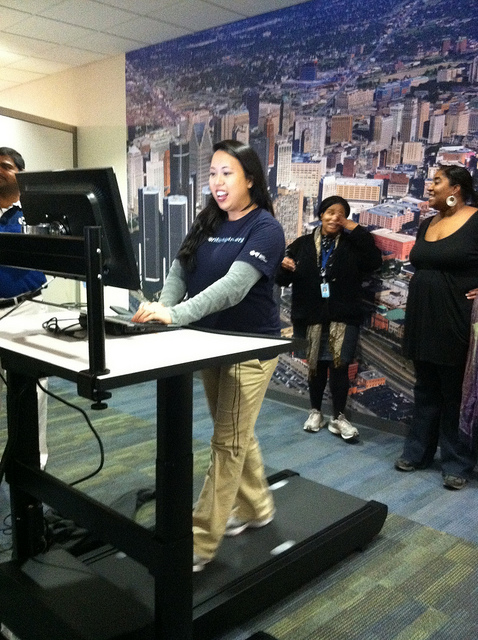
But what if you don’t have the budget of a multinational pharmaceutical firm? That’s where Greatist.com’s list of the 46 healthiest companies to work for comes in handy. Their “Tiny Business” category includes only companies with less than 100 employees. The top-ranked little guys include a Tampa law firm, a blogging platform, and a Milwaukee-based sports marketing company — a far cry from mega-corporations like GE and Pfizer. They may be smaller, but these companies operate under the same philosophy as the big guys: workplace wellness is worth the investment. OK, so providing free company lunches on Fridays, a regular fresh fruit delivery, or a handful of on-site bicycles for employee use may be a smaller investment, but the impact can be just as large.
Healthy, happy workers are key to a successful workplace, and there are solutions out there for companies of all sizes and industries. Whether this means healthy snacks in the breakroom, weekly office breakfasts, or full catered healthy lunches, Waiter.com can help your office find its ideal path to workplace wellness!
Eating for Energy At Work: How to Win the Blood Sugar Battle
Picture this: you’re running late for work, so you stop at the corner coffee shop for a latte and a doughnut for breakfast. Half an hour later, the caffeine and sugar have done their trick, and you’re plowing through your inbox with gusto. But by eleven o’clock, you’re exhausted again. What happened to all that energy?

Image source: flickr user avlxyz
Essentially, your energy levels have become a casualty of your own body’s natural methods to maintain equilibrium. Processed foods and refined carbohydrates, like those found in white bread, white pasta, and your morning doughnut, are broken down very quickly once eaten. This breakdown results in a burst of glucose flooding into your bloodstream, which raises your blood sugar levels and provides a boost of energy. That’s not so bad, right?
However, the sugar flooding into your blood also causes your body (specifically your pancreas) to release insulin. Insulin is a protein that whisks your excessive glucose away to the cells and resets your blood sugar levels to a more normal state.
This is a natural, healthy process, but when it happens too fast, it results in a quick up-and-down spike in blood sugar that leaves you feeling as though your energy levels crashed. But don’t reach for that bag of M&M’s to get another boost: there’s a better way.
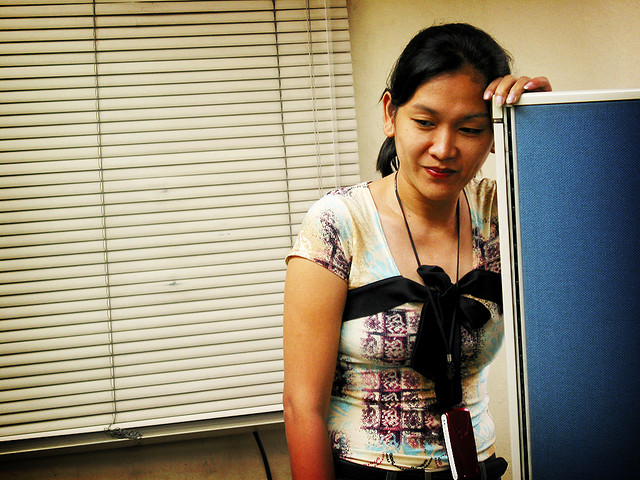
Image source: flickr user Stitch
Eating the right foods at the right times can stop the energy level roller coaster in its tracks. With a little planning, it’s easy to make eating for energy at work part of your office routine.
1) Eat a real breakfast. Unlike the speedy breakdown of simple carbs and sugary treats, protein-rich foods like eggs and Greek yogurt, and complex carbohydrates like oatmeal and whole grains, are broken down slowly, allowing a steady release of glucose into the bloodstream — giving you a consistent energy source throughout the morning. If your office holds catered staff breakfasts, lobby for whole foods to be incorporated into the menu, rather than just a box of doughnuts or basket of muffins.
2) Stock healthy snacks, and eat them! Grazing on low-fat and fiber-rich foods will keep your blood sugar from dipping too low, helping to maintain energy levels between meals. Plus, you’ll be less likely to overindulge at lunch. At the office, keep a supply of easily accessed snacks on hand: nuts, low-fat string cheese, sliced cucumbers and bell peppers, whole wheat crackers, and almond butter are all great choices.
3) Choose your lunch wisely. If your office uses lunch delivery, avoid pizza, pasta, and other carb-heavy options. Aim for an equal mix of whole grains, vegetables, and protein on your plate: think brown rice, broccoli, and chicken from the Chinese place, or a turkey sandwich on whole-wheat bread with an apple (instead of chips) from the deli. And don’t overdo it at lunch: stop eating once you’re full, and save the rest for a mid-afternoon snack. Harvard’s medical researchers have found that people who eat large lunches are more likely to be tired later in the day.

Image source: flickr user havankevin
4) Most importantly, just eat! Skipping meals is a surefire way to cause your blood sugar and energy levels to drop, and it only becomes more likely that you’ll give in to a bag of cookies from the vending machine when you’re ravenous at 3 pm.
Make eating for energy a priority in the workplace! Waiter.com makes it easy to provide healthy office snacks, healthy catered lunches, and to plan office event menus with energy levels in mind. A few small steps can make a big difference in keeping the entire office more energized and productive throughout the day!
Are Your Office Snacks Smart? New Study Shows Sugary Foods Can Damage Memory in Days
Does your office keep a candy bowl in the break room, or bring in donuts for impromptu staff breakfasts? New evidence suggests you may not just be indulging your sweet tooth when you partake in sugary snacks at work: you might actually be harming your brain, and specifically your memory.
A recent study at the University of New South Wales in Sydney has generated new evidence that high-sugar diets can lead to memory loss, and much faster than previously thought. Researchers fed groups of rats distinct categories of diets, including some supplemented with sugar and fat. The resulting impact of the change was nearly immediate: rats who were fed high-sugar, high-fat diets experienced deterioration in memory and spatial recognition in less than a week.
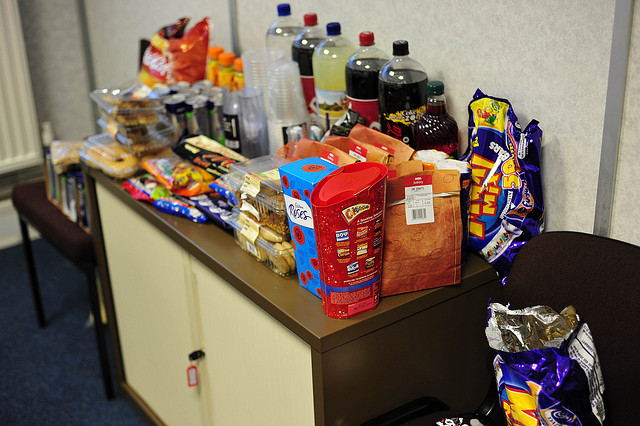
These findings aren’t entirely new. Previous research has long shown that increased blood sugar levels can affect the functioning of the hippocampus, which is important for memory in both animals and humans. Up until now, however, the research has mostly focused on longer-term effects and how a lifetime of unhealthy eating can damage our memory. As Professor Margaret Morris, the new study’s co-author, tells the Sydney Morning Herald, “What is so surprising about this research is the speed with which the deterioration of the cognition occurred.”
When it comes to humans, especially in the workplace, the implications suggest that our office snacking habits can have an immediate effect on our memory. Especially during the holidays, when treats and cookies can run rampant, that’s a hard pill to swallow! Employers may offer sweet office snacks in the break room to boost spirits and even provide a “sugar rush” during a long day, but the truth is that those cookies and donuts could be hurting your team’s ability to work efficiently… and remember where they left their car keys.

Of course, the answer is not to abstain from treats at work. Rather, snack smartly: provide a variety of break room fare, like nuts, vegetables, and hummus, or even a cheese tray for a special treat. Offer a fruit bowl rather than candy — fruit’s natural sugar, fructose, is metabolized quite differently than the sugar in most baked goods, and is a much better choice. In the morning, oatmeal and yogurt are healthier alternatives to pastries; however, look out for over-sweetened flavored varieties that can pack just as much sugar as a donut!
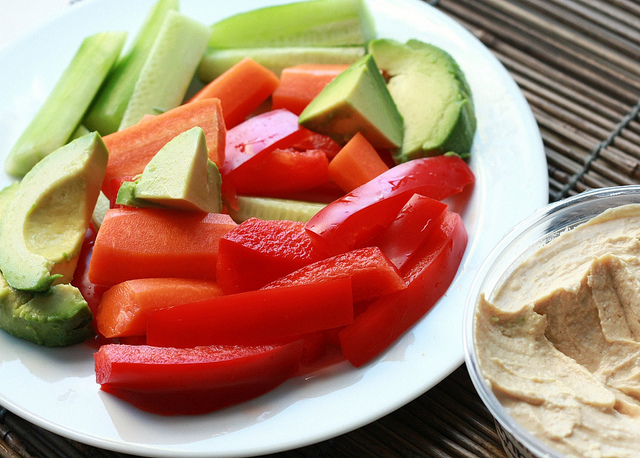
If possible, go beyond snacks and provide another level of benefit to your staff. Serving catered lunches with an abundance of healthy options is a fantastic way to show appreciation for your staff, generate excitement in the workplace, and to encourage eating wholesome meals rather than mindless munching. Waiter.com has a wide range of delivery options to please every palate, and our Virtual Cafeteria Service makes providing high-quality office meals just as easy as bringing in a box of donuts.
And if you can’t bear to ditch the candy bowl, at least choose wisely: the flavonoids found in dark chocolate may make it the smartest sweet of them all.
7 Easy Ways to Bring Brain Foods Into the Break Room

We’ve all seen it. It’s mid-day at the office, and everyone’s energy is dropping. Employees are reaching for their third or fourth coffee and a sugary muffin to get through the rest of the day. Unfortunately, this boost will only lead to another crash later in the afternoon.
Does this sound familiar? If you’re looking to improve efficiency and energy levels at the office, don’t send out a memo or buy a bigger coffee pot. Healthier snacks can help employees get through the day with energy to spare. We’ve collected seven of the best brain foods that are easy to incorporate into the company breakroom. These natural brain-function boosters may improve memory, focus, concentration — and employee morale.
1) Salmon
Salmon, along with sardines and other oily fish, is a rich source of the omega-3 fatty acids EPA and DHA. These essential nutrients (i.e., they must be supplied by our diet) have been linked to improved focus and memory, along with a lower risk of dementia. Instead of a box of doughnuts for a catered staff breakfast, spring for cured salmon to top bagels (or, better yet, whole-wheat toast).
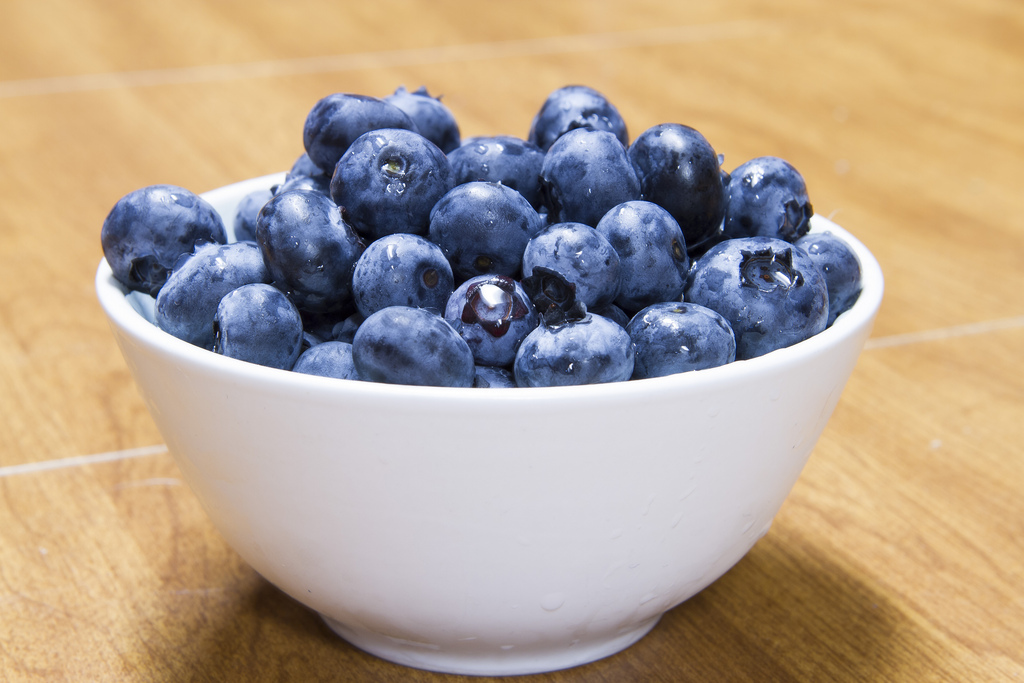
2) Berries
Blueberries and strawberries may win the prize for best brain food. In one key study, women who consumed as little as half a cup of blueberries per week slowed down their natural cognitive decline by an average of two years! Researchers believe the flavonoid anthocyanidin is key, as the compound seems to travel from the blood into the brain tissue, specifically around the hippocampus — the area of the brain responsible for memory and learning. In the break room, keep a big clamshell of fresh blueberries on hand for snacking, or stash a bag of frozen berries for yogurt toppings and smoothie add-ins.
3) Ground Flaxseed
Along with walnuts, flaxseed is one of the dietary sources of alpha linolenic acid, or ALA. This healthy fat is the vegetable-based source of omega-3 fatty acids, similar to those found in salmon, and has similar benefits of improving memory and focus. Keep a dish of ground flaxseed (the whole seed won’t be digested properly) in the refrigerator and encourage coworkers to sprinkle it on salads or morning yogurt for an easy dose of brain power!
4) Green Tea
We all know that caffeine boosts concentration, but there are better ways than coffee to access its benefits. Green tea not only provides the same mental stimulation as coffee; it contains specific antioxidants, phylophenols, that can add an extra boost of concentration. Stock the coffee station with tea bags, or brew a pitcher of iced green tea for a refreshing afternoon treat. Add a few orange slices for sweetness.
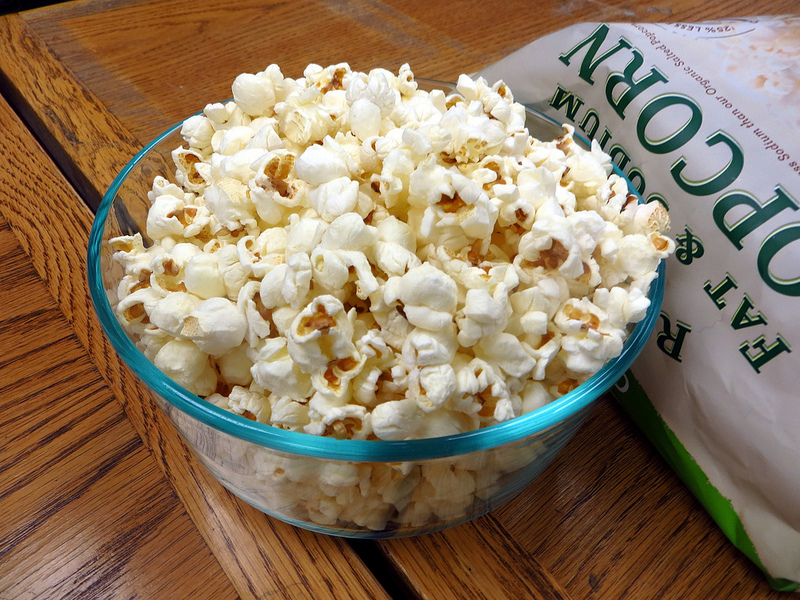
5) Whole Grains
At the very basic level, our brains need glucose to function. Glucose is the natural sugar found in carbohydrates, but it will be released into the bloodstream slowly and steadily when you eat whole grains — rather than the crash-and-burn effect of many over-processed breads and muffins. Stock the break room with easy, tasty whole grains like oatmeal and even popcorn for a sustainable energy supply (just check the labels carefully for impostors).
6) Eggs
Don’t skip the yolks! Eggs, specifically their yolks, are a rich source of choline — a nutrient that helps the body produce acetylcholine, a memory-boosting neurotransmitter. Easily microwaved in a coffee mug or hardboiled and stored in the fridge, keeping eggs in the break room is a surefire way to ensure your employees never skip breakfast… another brain-boosting strategy.

7) Pumpkin Seeds
This seasonal treat deserves to be a year-round staple: it’s one of the best dietary sources of zinc, a mineral associated with increased focus and concentration. For added variety, supply a bowl of pumpkin seeds, cashews, and almonds for a zinc-rich snack mix.
When it comes to feeding employees and coworkers, make your company’s food program really count! If your workplace dining plan needs to take it up a notch — or if you don’t have one at all — Waiter.com is here to help. From virtual cafeteria service to diverse menus to local takeout & delivery, Waiter.com offers customizable dining solutions for every business and budget. Contact us today to get started!